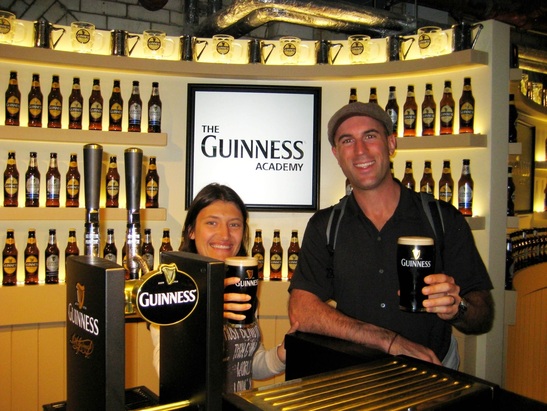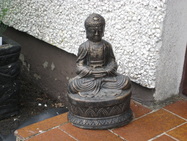





 The weeping Buddha is an iconic sculpture in Buddhist art. It is often carved by journeymen wood carvers from a single piece of wood to prove their mastery of the craft. Though there are various explanations as to its meaning, I have always believed that this weeping figure cries for the overwhelming suffering he sees in the world. It has always been a poignant image for me and it was on my mind as we traveled through Northern Ireland. But first things first - we traveled to Northern Ireland via a flight to Dublin. In our one day stopover, Jeff loaded up on passport pages at the US embassy and we spent a pleasant day at the Guinness Storehouse, a museum of Guinness brewing, history, and marketing. We also took a brief course in pouring the “perfect pint” and as luck would have it, some Jehovah’s Witnesses gave us their free beer tickets at the end of the tour…which almost made us miss our bus to Northern Ireland! 
Neda & Jeff learn to pour the perfect pint of Guinness...I learned that a draught of Guinness is infused with 80% nitrogen and 20% carbon dioxide at the tap - which is what gives it the creamy head and flavor. This wasn't invented until the 1950's, however, so before that a Guinness would be much more like a regular stout beer...
In the end some lucky tram timing got us into Londonderry (Derry according to some) on time. Northern Ireland, which is a separate country from the Republic of Ireland and is part of the UK, was a lesson in contrasts for us that can’t be understood without some brief history. It begins in earnest around the early 1600’s. A group of Irish earls fled the country (for reasons still debated) and their estates were quickly confiscated by the Crown. To secure the area for English (and Protestant rule), King James I (VI of Scotland) establishes a plantation scheme whereby the land is to be settled by low-land Scottish raiders living along the English border that he had banished for their crimes. James was tired of the constant border raids of these families and thought that he could solve two problems at once. He could force the migration of the raiders to relieve the troubles along the Scotland-England border while also spreading Protestantism and English rule to the predominantly Catholic population there. The raiders were joined by a plethora of other Scots and some English looking to flee harsh economic times in their countries.  Mussenden Temple near Derry Though the plantation system would eventually repress the native Catholics and lead to the loss of their land, it should be noted that the English Lord in charge of implementing the plantation, Arthur Chichester, thought that an equitable distribution of land to the native Irishmen and incoming Protestants would reconcile the locals to English rule. However, it only took one mishap to tip the scales towards inequality. One of the last remaining Irish earls named Cahir O’Doherty (who was actually an ally of the English in the 9 Years War) was punched in the face by the new governor of Derry George Paulet during an argument. This prompted O’Doherty to seek revenge by burning Derry and starting a rebellion. The rebellion was quashed and with it any chance for equitable distribution. Fearing the local population, King James ensured that Protestants received the lion’s share of the land, sowing dissent permanently into the native Irish population. This was compounded by the exile of all Catholic priests from the area in an attempt to convert the population to Protestantism. It is amazing how one punch can change the course of history. The plantation era in English-Ireland relations was not restricted to Ulster – if you are interested in more of the history you can read about it here. This oppressive situation continued until 1641 when the native Catholics staged another rebellion and brutally attacked the Protestant landowners and their families. This act of violence was met in kind by the enraged Protestants of Ulster and the cycle had begun. The next 400 years would be a continuing battle between protestants and Catholics, culminating in the late 1960’s with the beginning of what they call “The Troubles”. The troubles were a time of increased militant action between paramilitary groups like the Irish Republican Army (which wanted to see a united Ireland with no influence from the British Crown) and the loyalist Ulster Volunteer Force, who wished to defend their right to stay a part of the UK and to be Protestant ruled. After over 30 years of fighting, a truce was made with the Belfast agreement of 1998. Our experience was that while much of the paramilitary activity has subsided in Northern Ireland due to this truce, the tribal division between the two groups of people was still starkly evident.  Preparing the bonfire for 11th eve As we traveled through the North, various towns would be coated with either loyalist colors (the red, white, and blue of the United Kingdom Union Jack flag and the Flag of Ulster) or the nationalist colors of the Republic of Ireland (green, white, and orange). Even today, if boys living in a Protestant enclave near the center of Derry wander too far from their homes, they are swiftly given a beating by the Catholics surrounding them. We happened to be in the country on the 12th of July, a holiday where Protestants celebrate the victory of William of Orange over King James II at the Battle of the Boyne. This victory essentially sealed protestant rule over Northern Ireland. The evening of the 11th is marked by an enormous amount of massive bonfires lit by the Protestant population all over the country (we went to 3 alone in a little neighborhood outside Derry). The day of the 12th is then followed by talented marching bands touting the orange colors and Ulster Flag as they march through Catholic and Protestant neighborhoods, celebrating a victory that divided their country 400 years ago and left the native population as 2nd class citizens.  Partisan flags fly in most neighborhoods As I watched this parade, the image of the weeping Buddha was strong in my mind. I could see him crying at the terrible suffering that both sides of this battle had endured. Long ago this conflict stopped being about who is wrong and who is right as the vicious cycle of violence followed by revenge played out over and over. The hardcore Catholics side was unwilling to forget the way their land was occupied and accept that the Protestants are a legitimate part of their country now. The hardcore Protestants were terrified that a Catholic majority will lead to them becoming 2nd class citizens out of revenge. While the Belfast Agreement has led to non-violent power sharing for the last 15 years, the sectarian separation between the people of Northern Ireland has not abated. While all of this conflict and hatred can seem overwhelming, our experience in Northern Ireland was still defined by smiling Buddhas more so than weeping ones. Our friend Iain (who Neda had only met once before we came to see him in Derry) planned a whole 4 day itinerary for us while we were in his country. He and his family graciously invited us to stay in their home as we traveled to the geological wonders of the Giant’s Causeway and the Marble Arch Caves. Iain’s friend Alex took us on a wonderful tour of the city walls of Derry, fielded all my questions about the history of the region, and even served us a delicious high tea. Random folks at the pubs bought us pints of Guinness and welcomed us to their country. It was clear that the kindness of human nature was still shining through in Northern Ireland, despite the fog of division that rested over the country.  June's Smiling Buddha Nowhere has the contrasts in a country been so evident than during our visit to Northern Ireland. Nowhere have we seen such separation between people and yet nowhwere have we been given so much love. A warm thank you goes to June and John, Iain’s parents, who cooked wonderful meals for us, took us on hikes in the area, and shared their stories with us. See the wonderful pics of the sunny days we had at Giant’s Causeway, Mussenden temple, Carrick-a-Rede rope bridge and more here: http://flic.kr/s/aHsjAF5GrA
4 Comments
Jane
7/21/2012 04:17:45 pm
don't y'all look adorable, w/ the Guiness and each other...oxo
Budd Robertson
7/23/2012 09:10:49 pm
I totally enjoyed this post and the history of the conflict. I was just curious, during the time of your visit a controversy was playing out involving a dog named Lennox that was confiscated and put down by the Belfast City Council. Was there much discussion of the matter locally? It received a great deal of attention in the States. 7/24/2012 12:11:04 am
Hi Budd, Leave a Reply. |